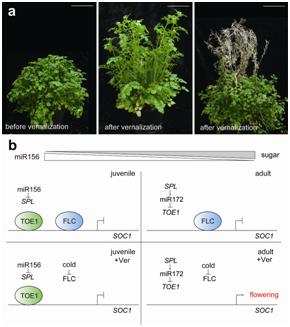Plants have different life forms, such as annual, biennial and perennial. Most polycarpic perennials flower over many seasons in their lifetime. How perennials undergo repeated cycles of vegetative growth and flowering is poorly understood.
C. flexuosa, a member of the Brassicaceae, is a herbaceous perennial. C. flexuosa has an obligate requirement for a week- to month-long cold temperature, a treatment known as vernalization, to induce flowering (fig. a). The plants younger than 4 weeks old could not respond to cold. Dr. WANG Jiawei at Shanghai Institutes for Biological Sciences and his colleagues revealed that the levels of two microRNAs (miRNAs) contribute to regulating the timing of acquisition of floral competence in response to cold treatment in C. flexuosa. Floral induction is achieved only when the old plants are exposed to cold for at least two months (fig. b).
Mechanismly, age and cold coordinate to regulate floral induction in C. flexuosa by removal of two repressors, CfFLC, which is repressed by cold treatment, and CfTOE1, which is down-regulated by the miR156-SPL-miR172 cascade. In the young seedling, high levels of miR156 lead to the accumulation of CfTOE1. CfTOE1 represses CfSOC1 expression regardless of cold treatment; as the plant grows, the endogenous sugar content is elevated, resulting in a decreased level of miR156 and the concomitant increase in miR172. As a consequence, the occupation of CfTOE1 at CfSOC1 promoter was reduced, leading to a “cold-sensitive” state. Flowering can be successfully induced when CfFLC expression is reduced by cold treatment.
The integration of age and cold response offers advantage for perennial growth habit, by ensuring plants do not flower until they develop axillary shoots and gain enough biomass. This work also suggests that the species-specific imbalance of repressive versus inductive floral inductive signals determines the life cycle strategy of flowering plants.
This work entitled “Molecular Basis of Age-dependent Vernalization inCardamine flexuosa” was published in SCIENCE on May 31, 2013.
This work is supported by the grants from National Natural Science Foundation of China, State Key Basic Research Program of China, Shanghai Pujiang Program, Recruitment Program of Global Expects (China), and the start-up fund from Shanghai Institute of Plant Physiology and Ecology to WANG Jiawei.

Genetic framework of flowering time pathways inC. flexuosa(Image by Dr. WANG Jiawei’s Group)
|
| |
|

